Two straight weeks, two straight heart attacks, 2-0. Notre Dame nearly suffered a massive upset against Toledo despite dominating the efficiency battle, as several concerning storylines from Tallahassee followed the Irish home. For a second straight week, the defense dominated long stretches of the game and wreaked tons of havoc, yet surrendered huge plays to keep the Rockets in the game. Again, the Notre Dame offense looked hopeless running the ball (except when Tyler Buchner infused life), adding three costly turnovers to make things even more difficult this week.
91% postgame win expectancy for ND, equivalent to about a three-score win. Massive success rate advantage and some bad turnovers luck.
SP+ never ever ever says what you think it will about the Irish…https://t.co/LtobmbX5Xm
— Bill Connelly (@ESPN_BillC) September 12, 2021
No garbage time in this game, which was disheartening! The only plays excluded from the data are end of half and end of game kneel-downs. Confused? Check out this handy advanced stats glossary here or reach out in the comments.
Explosiveness
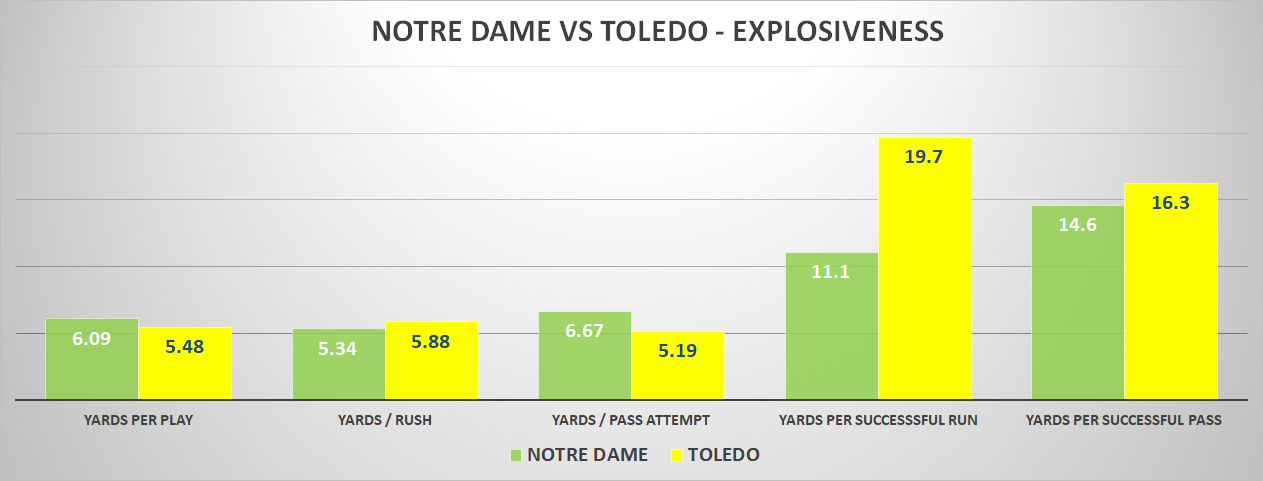
The 7 longest plays allowed by @NDFootball defense through two games account for 354 yards (89, 67, 66, 60, 26, 25, 21)
The other 130 defensive plays? 441 yards
— Irish Sports Daily (@ISDUpdate) September 12, 2021
The Marcus Freeman era continues to be extremely volatile, with incredible stretches punctured by massive chunk gains. With four plays allowing 60+ yards, the Irish defense has now given up more of those gains in two games under Freeman than three years under Clark Lea (two in 2020, none in 2019, one in 2018).
It would feel downright Van-Gordian if it wasn’t for how successful the Notre Dame defense has been for the vast majority of snaps. The “take out the big plays and now the stats look good” game is cheating, but it’s far from meaningless – consistently limiting efficiency, creating havoc and negative plays – those are signs of potential. The Irish allowed 63 yards combined in the second and third quarters against Toledo. Unfortunately, in that same stretch, the Rockets outscored Notre Dame 10-7, thanks to a pick-six and short field goal drive after a failed fourth-down attempt.
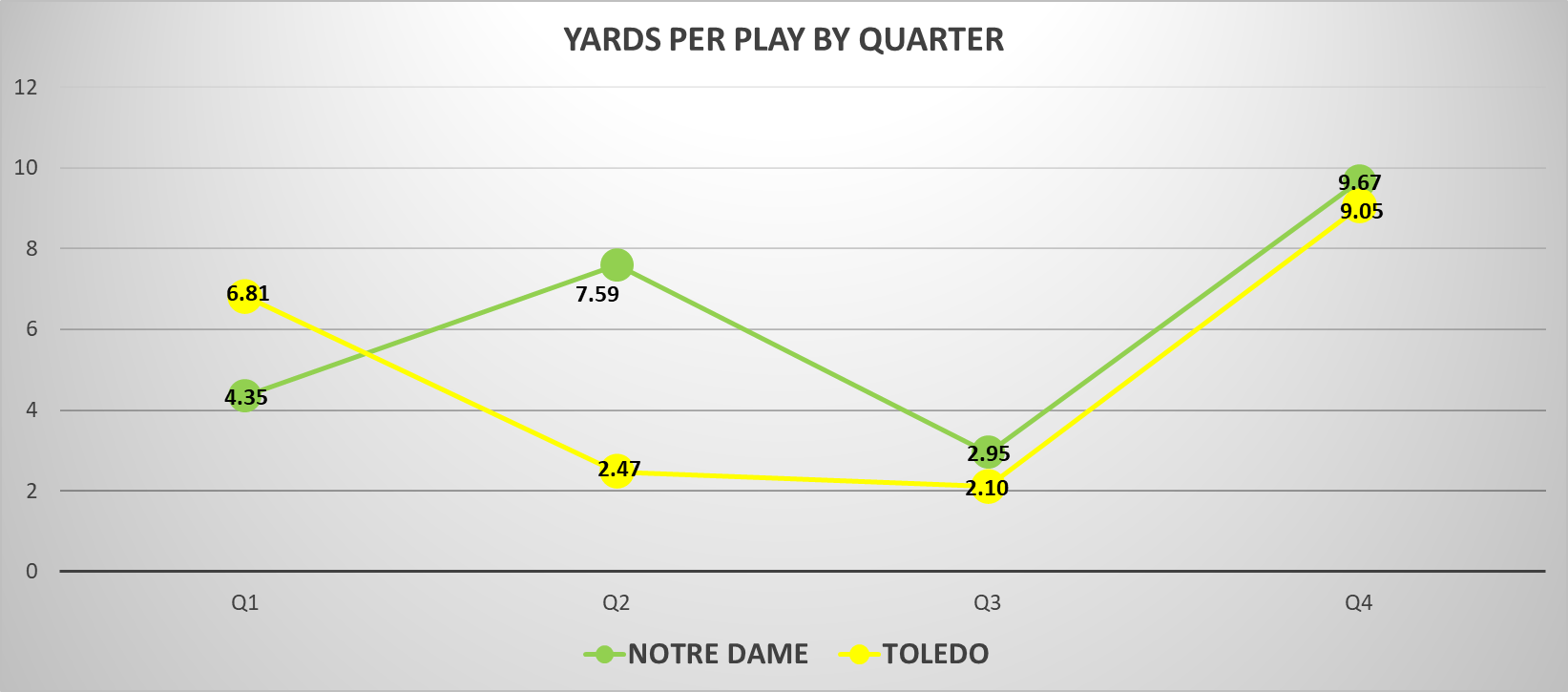
The $64,000 question is if ND can drastically reduce these explosive plays. It’s entirely plausible that these are underestimated growing pains in the Lea-Freeman transition – it’s only two games, with many new starters in the mix and Freeman understanding the strengths and limitations of his personnel. It’s easy to envision a world where the defense dials the aggression back a touch, tackling improves, and these dominant halves start stretching into games.
Still, it’s troubling these big gains have come against a shaky FSU offense and Toledo. However you’d like to judge the Rockets, there will be many better offenses coming later on the schedule that will be more difficult to create havoc against, make inefficient, and clamp down on the chunk plays. Schematically it seems like there’s some inherent conflict between the way Freeman wants to play and the Irish personnel – how many players can hold up in man coverage, what is being asked of defensive ends, and how the Irish line up against receiver heavy formations.
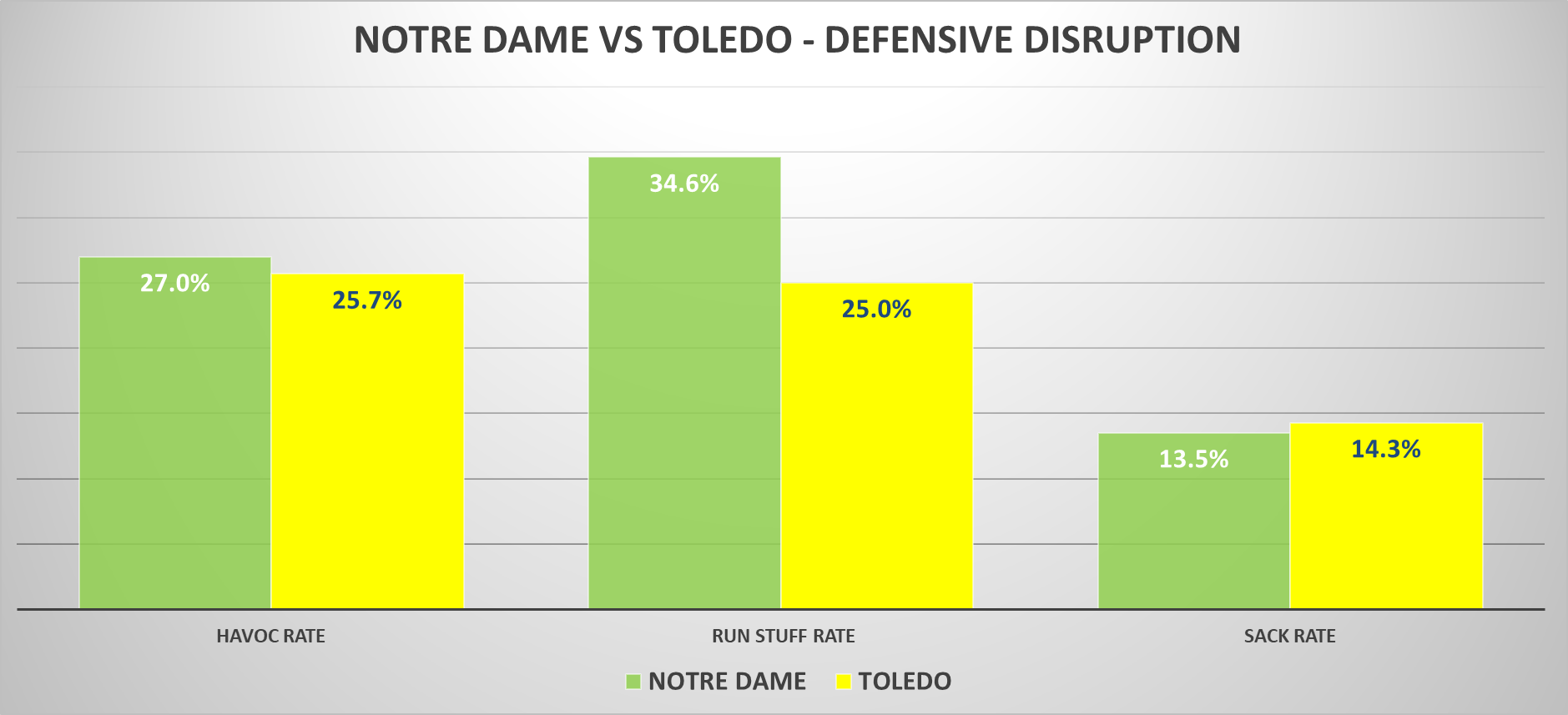
Both defenses generated a ton of negative plays, with impressive numbers stuffing runs behind the line of scrimmage and rushing the passer. Players at every level stepped up to generate disruption for Notre Dame, including Jayson Ademilola, Isaiah Foskey, JD Bertrand, and of course, Kyle Hamilton. For the Irish, this was expected, but the Toledo defensive line causing this many problems…not so much.
Efficiency
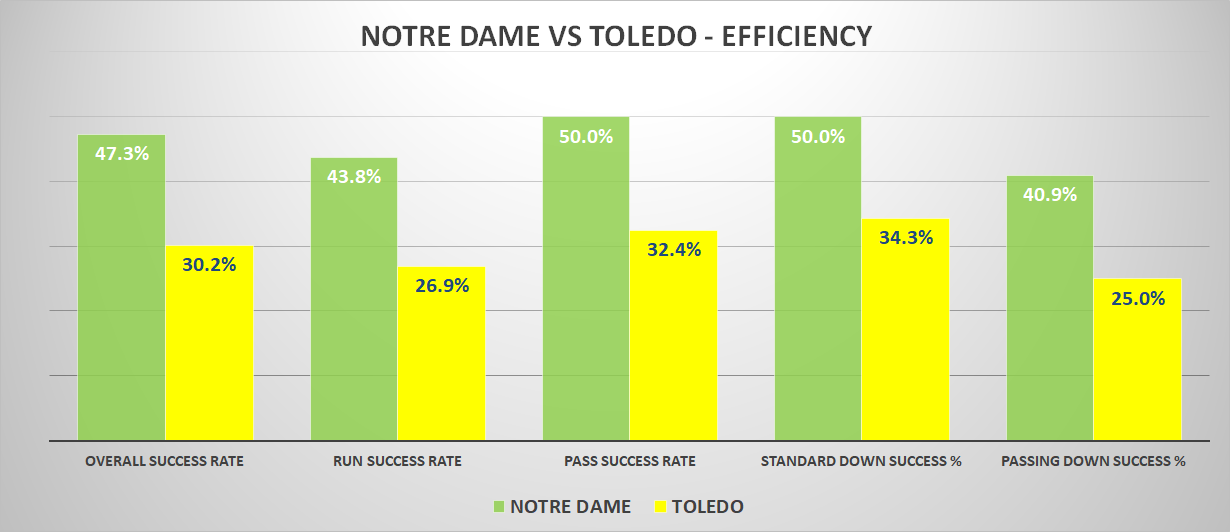
Bill Connelly’s tweet may have ruined the surprise, but the Irish dominated the success rate battle under the radar. Teams with a margin of +10-20% in success rate win 92% of the time with an average margin of +17 points. It was a close call reminiscent of Virginia Tech in 2019, where Notre Dame had no business playing a close game down the stretch, but turnovers and a few big plays nearly led to a horrific outcome.
We’ve somehow made it this far without talking about Jack Coan, Buchner, the offensive line, and the conundrum that combination presents for Brian Kelly and Tommy Rees. It’s a minor miracle that the Irish scratched together efficient offense with the offensive line struggling mightily, requiring defibrillation with Buchner’s legs to get anything going on the ground and constantly allowing Toledo to harass Coan.
Even with Buchner’s rushing contribution, including his presence helping open things up for the long Kyren Williams touchdown run, the running stats are abysmal through two weeks. Notre Dame is 121st in stuff rate allowed, 119th in offensive line yards, and 104th in opponent havoc rate. With Coan in the running game has been virtually nonexistent, with Williams and Chris Tyree routinely facing contact immediately at the line of scrimmage.
The Notre Dame staff seems caught between two paths, although they may continue to split the difference as they did in the home opener. It’s worth noting Brian Kelly is no stranger to playing two quarterbacks, from the ill-fated DeShone Kizer and Malik Zaire ping-ponging in 2016 to a pretty successful Tony Pike – Zach Collaros timeshare at Cincinnati. Buchner’s talent and allure are incredibly tempting, and his ability to assist the run game is desperately needed. However, it’d be foolish to assume he’ll be just as effective against better talent that has time to prepare for his running ability. Fully turning to the true freshman could also mean losing some rare offensive components working right now despite the line – quick reads to Mayer, screen passes to the backs, and back shoulder throws to Austin that Coan has excelled at.
Then through no fault of his own, Coan is simply a poor fit with the state of the offensive line. The pick-six was horrific, but he’s averaging 8.7 yards per attempt and completing 70% of his passes (when he can get the ball away). But a traditional running game is dead in the water with Coan in, and his style of staying in the pocket is going to lead to a lot of sacks every game. Rees and the offense can help him out more – give Coan more play-action and continue to spread the field horizontally with more receivers. Leverage more pre-snap motion, opening up quick passes to the flat that act almost as runs but avoid the weak line and still allow Tyree and Williams to shake loose. Add more misdirection and eye candy with the threat of receivers in the run game. Still, no matter what, the rushing attack will have an inherent ceiling with Coan that doesn’t exist with Buchner. The path to success with the Wisconsin transfer requires a pass-heavy attack that’s diametrically opposed with Notre Dame’s recent offensive identity (note – this isn’t a reason not to go this route, simply an observation of why it may not happen).
Finishing Drives, Field Position, & Turnovers
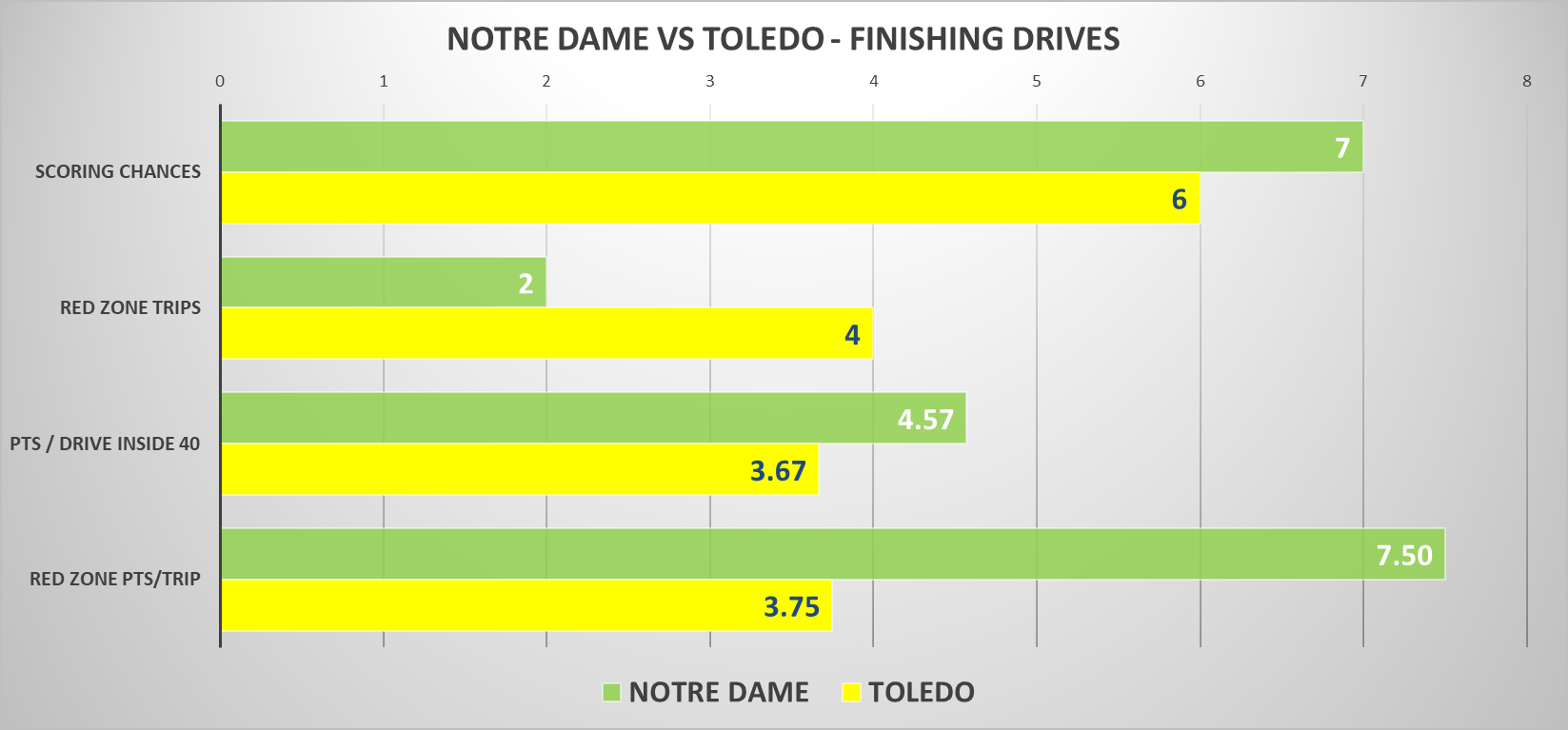
The Irish barely edged Toledo in generating scoring chances and were fortunate the Rockets had to settle for so many field goals in the red zone. For a second straight week, a team averaged over 7.0 points per red zone trip, thanks to Avery Davis’ insane 2-point conversion to give Notre Dame a three-point lead.

Notre Dame was slightly unlucky in the turnover battle, losing both fumbles and the only team to throw an interception despite similar pass break-up numbers for each team. Over the course of a season a team is expected to recover around 50% of fumbles (truly a coinflip, although individual fumbles can vary based on where they take place) and about 22% of passes defended turn into interceptions. For the Irish not to come away without a pick in this game (according to replay, at least) was also unlucky.
Of course, the big story with the turnovers was just how consequential they were – no arm punts on 3rd and long here. In fact, three of Notre Dame’s four biggest plays by absolute EPA on offense with the three turnovers, which lost approximately 18 points by EPA calculations.
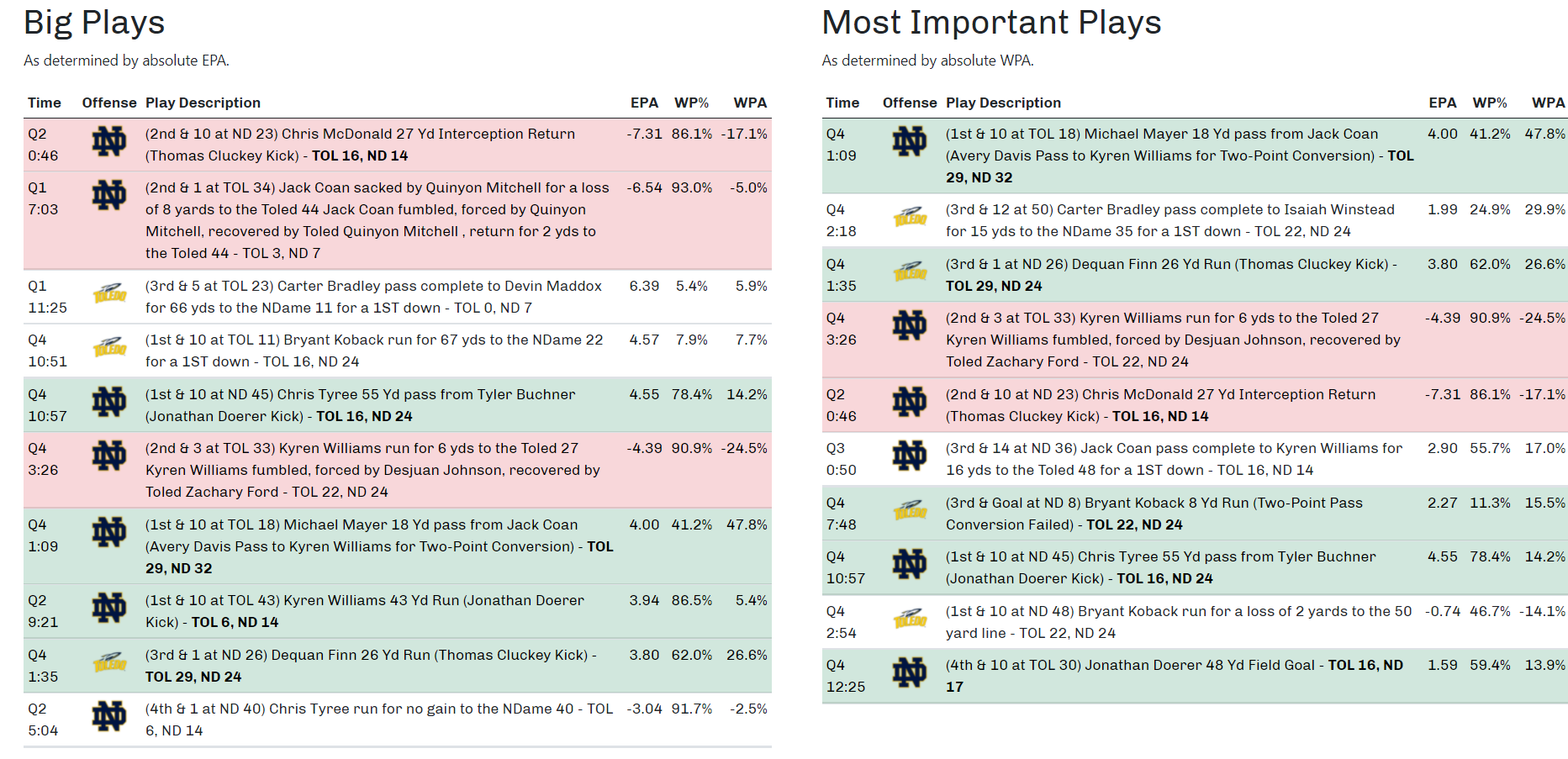
On to Purdue
After one week we always caution against overreaction but find plenty of storylines and red flags to keep an eye on. The concerning themes from the Florida State game continue to be worrisome, for the most part. If anything, the introduction of Buchner to the offense just introduces more uncertainty to a team that already seems to have a hard time knowing its identity. The Boilermakers were quietly solid on offense last year, have a defensive end I feel very confident predicting Notre Dame cannot block and are only a single-digit underdog in the early lines.
At the very least, this isn’t boring, right? While the opponents don’t match up cleanly, there are a lot of parallels between the start of this season and 2018. After the Irish wheezed past Ball State and were outplayed in many aspects by Vanderbilt but escaped with a win, I wrote some perspective that feels somewhat fitting three years later:
S&P+ gave Vanderbilt a 56% win probability looking at the final stats of this game – one where the YPP edge went to the Commodores, along with more scoring opportunities and some bad turnover luck. These numbers echo what a lot of Notre Dame fans at this point feel – that this team is maybe a bit overrated (18th in S&P+) and due for a letdown any week now.
While by no means is this team a finished product, even if that is the case, I’d argue we should embrace it. These weekly reviews are a lot about the numbers and projecting things moving forward, but speaking from the heart instead of the brain for a second, how fun would it be to scratch out a bunch of close games with a clutch defense, streaky offense, and lethal kicking combination? Would anything make the Notre Dame-hating college football world madder than an Irish team like, say, 2014 FSU, that just keeps winning close games and getting hype despite not being great? I’m all for winning these ugly games, maintaining a spotless (or close record), and having Kirk Herbstreit putting us on upset alert every week.
… I would love to see Notre Dame come out and dominate against Wake Forest, but if they win by three or something it will be time for full-on Trolltre Dame, the top-10 team everyone thinks is overrated but just keeps winning.
Do not mistake this as a prediction for 12-0; at this moment I’m not confident this is a better football team than six or so teams left on the schedule. The expectations and formula are different this year, and we’ll see if a quarterback change ends up sparking the offense as it did with the beginning of the Ian Book era. But the outlook can definitely be applied as long as the winning continues, and in the big picture, that has to remain the goal even if expectations are being readjusted.
Preparing and developing young players for the future is important but so is recruiting, and recruits tend to like ranked teams, great atmospheres, major bowl games and big games. On the table this year is still:
- A Soldier Field battle against Wisconsin already in one network’s #1 spot
- A potential top-10 matchup hosting Cincinnati that could very well draw ESPN Gameday
- The road trip to Lane Stadium that sneakily could see undefeated Virginia Tech against a hopefully unscathed Irish team
- A chance to shovel the final dirt of Clay Helton and David Shaw’s graves (although I wish they’d both stay, they’re trying hard and doing great)
Buckle up, everything is still in play. Despite the early struggles the Irish are a top-20ish team in most advanced metrics and has already seen three of its scariest opponents pick up ugly losses two weeks in.



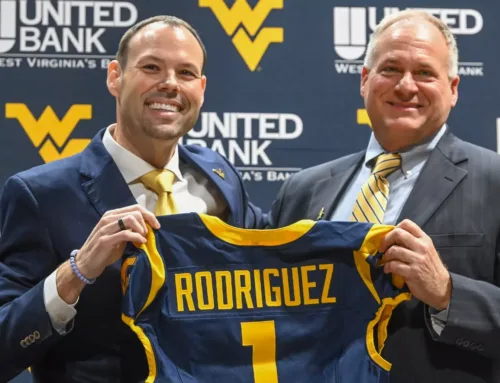
Me: Well at least we should end up playing an easier bowl opponent this year.
CBS Sports: Currently predicts an ND Clemson Peach Bowl matchup.
As for the D, I am curious as to whether we will be saying the same things at the end of the season as we are saying now. It seems like Freeman is able to create havoc by taking chances with aggressiveness, but because of that, there is an increased probability of a blown coverage or missed tackle that is going to happen at times leading to a big play.
i don’t have the X’s and O’s expertise but i’m hopeful it’s fixable, either cleaning things up or dialing back the aggressiveness after realizing it’s going to generate too many holes. playing the Vyper guys at the LB level, I haven’t found anyone that has a very good explanation for.
some of the plays have been execution – the long FSU TD run and long Toledo run that set up the 4th quarter TD didn’t seem like aggressive scheme at all, just poor run fits and angles and tackling. the passing plays are another story, and I worry good OC’s (with better WRs) will be able to generate 1-on-1 matchups with Griffith, whatever 3rd / 4th DB’s we play, etc. until we help them out more.
I’m glad to see your sober take on Buchner. On some other sites I have seen the typical knee-jerk reactions to start him, but as you noted here, teams will no longer be surprised by him and we do not know how much of the playbook he can handle at this point.
I think that calling some more plays to help out Coan (because of the o-line resembling swiss cheese) and occasionally mixing in Buchner is the way to go for now. I’d like to see some more spread WRs with quick throws, screens, plus some planned shots deep (but not holding onto the ball too long) to keep try and keep the pass rush at bay a little.
It’s almost shocking how little they call screens, unless it’s 3rd and long and they’re just kinda hoping for something good to happen (which, it has!). Given all the penetration the other teams are getting, you’d think a screen or two is a nice way to get Kyren the ball and give the defense something to think about not being too aggressive.
Strongly agree with this. Correll seems like he can operate in space pretty well but is not a bulldozer given his size. Lugg seems similar, maybe having to do with his reduced weight / back issues.
Let’s try some more misdirection and screens to play to their strengths, outcomes can’t be that much worse than the inside zone / delayed handoffs.
That said, Rees isn’t stupid. So unlike the NDNation crew, I’m inclined to think there’s another reason why we aren’t doing these things, would love to hear about it. Chesterton’s fence and all!
I think and hope they’re at a turning point now and will keep going further and further this direction (screens, quick hits, RPOs, spreading out). Not sure they really knew what they were working with until FSU, and even then we’ve seen a precipitous drop-off from there with Fisher out. You can explain away the missed offensive chances in Tallahassee more easily – their DL is actually good now, some lost possessions included drops or errant passes, the Noles set out to stop the run game, new OL needs to communicate better, hostile environment.
But Toledo’s front four winning like that? You can’t explain that away.
I didn’t go back and look but was it really the front 4 of Toledo? I thought it was LB like ex-ND Jonathan Jones who was living in the backfield. He got his name called a ton.
Granted, making a MAC team look that good is it’s own damning statement in and of itself, but I thought they were fairly aggressive and a bit exotic to confuse the OL with who was blitzing or not.
yeah thats probably an oversimplification, but more generally getting at that they were able to get run stops and pressure without bringing the house every time (although when they brought guys, that worked well too)
And can we shitcan the slow-developing running plays? I’m inclined to ask for it to be forever but would settle for the rest of the 2021 season. If I see one more play where Coan and Williams meet & exchange pleasantries before the handoff and then Kyren slowly ambles east/west up the line before being tackled by the backside DE for a two-yard loss, I’m going to lose my mind. I’m not sure what sort of offensive personnel makes that turd of a play call a winning staple, but it certainly isn’t what we have at this moment in time.
Great article. Defense and OL is taking up a lot of the oxygen but the turnovers are the biggest part of that game that aren’t getting enough reflection. And, shoot, if they didn’t overturn that Hamilton INT, this game might have been a lot different…Feels like in both games ND has not been getting some breaks to blow a game open, stub their own toes, make it too interesting.
Agree on the offense philosophy to help Coan, it’ll be fascinating to see what direction Rees takes it from here. I think it’s smart to have a package for Buchner to hit the defense with, but when Coan is in they need some quick developing plays or at least an outlet somewhere for him to dump it.
Yeah, every play from here on out needs to basically be one of:
1) Play action, throw to the first read or throw it away
2) Screen pass
3) Quick slant/out route/curl route
4) At least one extra blocker kept in to protect Coan
5) A Buchner RPO/rollout
Anything else and it just seems much more likely we will be taking a big loss than gaining positive yardage.
I wonder if that’s what Kelly meant by: we have a lot of good players and we could go a few different ways with this but we need to basically pick an identity.
In other words, do we want to just throw it all over the place and utilize our WR’s with Coan or do we want to bring in Buchner and really emphasize our talented RBs?
Let’s hope he can find a way to do both in an effective way until the OL improves.
I still can’t get over them overturning the Hamilton interception. From what I saw, there was zero evidence that could make me positive that he did not have it.
One thing that I hate about replay — they need to add a timer that is 1 minute max and just take a quick look. If the replays clearly show that they call was wrong, then overturn it. Otherwise, get back to the game and accept the call on the field. I hate when they study every angle for what seems like 10 minutes or when they break their own rules (where was the indisputable evidence that Hamilton did not catch it?)
Yea very surprised we don’t see more play-action. Pretty sure I’ve read the analytics that we don’t have to have a strong running threat for play-action to work. But it makes everyone pause by looking at the RB before dropping into coverage. Coan seems to be great at throwing down the field and maybe playaction would also give him that extra half a second to be able to throw it relatively deep.
You are correct. Here are some fairly stats heavy articles. But the gist is that the frequency and effectiveness of your run game have no impact on PA (first article), and you basically cannot run PA enough (2nd article).
https://www.footballoutsiders.com/stat-analysis/2018/rushing-success-and-play-action-passing
https://fivethirtyeight.com/features/can-nfl-coaches-overuse-play-action-they-havent-yet/
yea exactly. I don’t understand why you wouldn’t practically run play-action on almost every passing play (slightly adjusted for how long to gain depending on the down – e.g. 3rd and 20 – don’t bother play action; but 2nd and 12 could obviously include a play-action).
More aggressive use of pre-snap motion would help too. I loved the play where KJ Wallace got hung up and burned deep by Toledo. Now imagine running that with Lenzy. Against 90% of college CBs, that’s a guaranteed 5 yard completion, unless they press up, and then it’s guaranteed he’s getting multiple steps on the DB deep downfield.
Tommy hasn’t been shy about using motion, but it’s almost always a TE or RB. Very rarely has he used WRs in aggressive sprints from one side to the other.
Would love to see Lenzy motioning. Give him the jet sweep. Or run an RPO to put it in his belly and maybe take the ball back and fire to Mayer on the other side of the field if the defense bites on Lenzy.
They don’t have last year’s power run offense, might as well attack the edges of the defense and the seams to keep them honest.
14/20 for 250 yards and 2 TDs on play action so far, per Greg Flammang on Twitter.
I have been asking for more play action for several years and we just don’t use it very much. It’s baffling
I always wonder about OCs who don’t use motion and PA. There is tons of excellent analysis out there that tells us how effective PA is. How do professionals not see that and utilize it?
I mean there’s no possible way that we are more aware of the effectiveness of PA than a D-1 OC, right? right?????
To be fair to Rees, we are averaging 10 play action passes per game. I’m not sure if there’s a place to find college stats on this, but Tom Brady, the most effective play-action passer in the NFL, was only averaging about 7 per game last year.
That being said, teams like the Rams are using play-action on over 1/3 of their passes. Hopefully Rees can keep ramping up the play-action and screens in the coming weeks. It seems like Wimbush’s inability to throw a screen absolutely broke ND’s willingness to throw them. The 2 per game we’ve been throwing per game so far have been massive gaining plays. With Williams, Tyree, and Lenzy, that’s a big play waiting to happen every time we can get one block on the outside. Heck, I’d even love to see some middle screen action to Mayer if we’re feeling wild. After all, how are the D linemen going to be able to tell if we’re intentionally letting them through or it’s just a normal blown pass protection?
The part about the OL blocking, is sad but true at this point.
OT: Has anyone ever subscribed to PFF to see their gradings of players (for college)? They have a 30% off promo and I was thinking about checking it out.
I gave it a look but the grades themselves I remain skeptical of. I was reading an Athletic article this morning that Wisconsin’s LT had a pass block grade of 0.0 against Penn State and then 100 against Eastern Michigan…huh? When I’ve seen ND grades they also seem ok overall for the season but game to game very counterintuitive.
I have checked out their stats package, because they do track things I don’t have access to like play action, formation %, blitz and pressure rates, etc. But it’s a healthy chunk of change and some of those stats are not too meaningful until you have a big enough sample at the end of the year, so I’ve never pulled the trigger.
makes sense. thanks for the feedback.
This is a really great breakdown Michael. Good work.
Also – whoever asked me the other day if I thought Helton would make it to October, he did not make it…report is it’s Fickell’s job to turn down. Now that would be something…
TY!
While Fickell makes sense with the relationship with Bohn, I’d be pretty surprised if they went that route over a splashier recruiter like Cristobal or Franklin. Fickell and Campbell are clearly great coaches but both have been very choosy about opportunities and may not really fit LA.
But if it did happen, hard to see Cincy not having Freeman toward the top of their list. Weirdly I think the move to the Big 12 will actually make Cincy a worse job? There’s probably a slight prestige and pay bump but the job security and ability to jump to a high P5 job gets significantly tougher.
Interesting. I was thinking the move to Big 12 would make Cincy a better job since they could recruit better and Cincy could just become a powerhouse itself. But perhaps that is just wishful thinking.
I too picked October for the first firing. But the one area I have been optimistic lately is USC holding onto Helton. Alas, it was not meant to be.
They should have waited until next year, then they could have hired Urban.
Nonresponsive to this post, but: I’m watching the replay on Peacock and it is a terrible experience. The broadcast is pretty bad (they came back from a commercial break in the middle of a play where we fumbled?) and they include the commercial breaks in the replay?
When you combine this with the 90+ second real-time delays, they need to scrap this experiment for a few years at least.
It was brutal for me. On top of being behind the actual action by about 90 seconds like you said, I was behind others even in the Slack chat. Super frustrating. I had to exit out and log back in 3 or 4 times as well. Just a bad experience overall.
I watched the replay Sat night and it was awful. As you noted, why even have the commercial breaks? Also, actual commercials might have been better than the blank and quiet screen they showed during those breaks